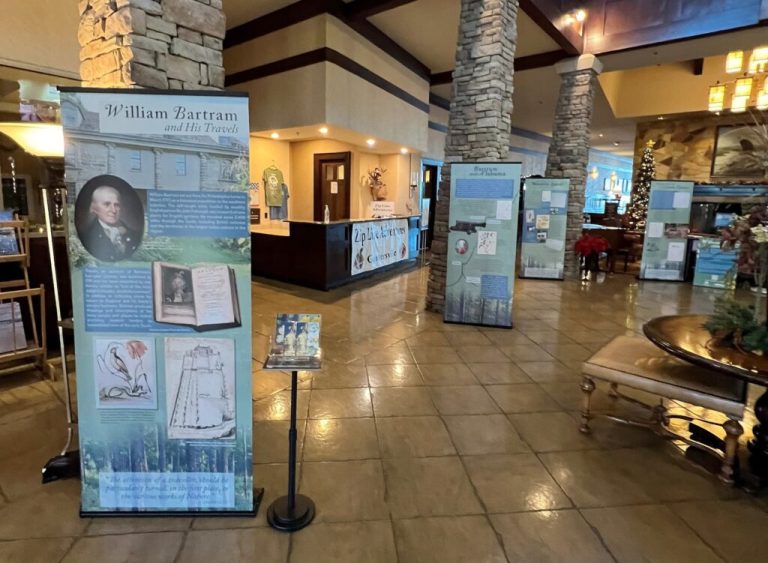Reviewed by: Pat Byington
Alabama family discovers 32-million-year-old sea turtle fossil
Reading time: 5 minutes

What started as a family fishing trip along a quiet river has turned into a significant paleontological discovery in South Alabama. Read on to learn more about the Ueloca fossil and how you can see it at McWane Science Center in Birmingham.
A chance discovery during a fishing trip
For years, South Alabama residents Adam and Adrienne Coleman have taken their two children on regular fishing trips near their home. During those trips, the family takes regular breaks to search for fossils along the riverbank—a hobby Adam picked up from his father.
“My dad got me into collecting fossils when I was a kid. Now we look for them every time we’re on the river.”
Adam Coleman
In the spring of 2021, the Colemans discovered an extraordinary fossil embedded in a massive limestone boulder. Unable to identify it and unsure of who to ask, the family decided to keep it a secret—but regularly visited the find.
“I’d never seen anything like it. We knew it was probably a fossil, but there was no telling what kind.”
Adrienne Coleman
After more than a year, Adam contacted South Alabama paleontologist Dr. Adam Gentry to see if he could identify the find. Gentry—whose research focuses on the fossil turtles of South Alabama—realized that the Colemans had uncovered the fossilized shell of an ancient leatherback sea turtle.
A significant find dating back 32 million years

After the discovery, Dr. Gentry put together a team of researchers from McWane Science Center, the Geological Survey of Alabama, Dauphin Island Sea Lab, Alabama Aquarium, and the National Oceanic and Atmospheric Administration Corp to assist in retrieving the fossil. After an enormous effort, the fossil was transported to a research lab for study.
“This is truly a one-in-a-million fossil. Specimens like this one are why Alabama is quickly becoming a globally recognized hot-spot for fossil diversity.”
Jun Ebersole, Paleontologist and Director of Collections, McWane Science Center

The fossil—which dates back to the early Oligocene Epoch (~32 million years ago)—represents a new genus and species of leatherback sea turtle. Dr. Gentry noted that the fossil was one of the most intact leatherback turtle shells known from the Western Hemisphere—a significant find.
“Leatherback sea turtles are unique for having a shell made up of a mosaic of tiny bones called ossicles instead of the broad, flattened plates typical of most turtle shells. When leatherback turtles die, the collagen that holds the ossicles together quickly decays and the mosaic falls apart. This makes intact fossil leatherback shells exceptionally rare.”
Dr. Adam Gentry

Because the fossil was recovered from an area that is part of the Poarch Creek Indians’ ancestral homeland, and a member of the research team is a Tribal Member, the team decided that the new leatherback turtle should be partly named in the Creek language of Muscogee. The new genus name Ueloca (pronounced Wee-low-juh) was created by combining Muscogee words “Uewa” (pronounced Wee-wah), meaning water and “Locv” (pronounced Low-juh), meaning turtle.
“This is the first fossil to carry a Muscogee name and it’s exciting to see our language recognized in this way. Opportunities like this weave our voice into history and ensure it’s never forgotten. I’d like to thank Dr. Gentry for allowing the Tribe to be a part of this unique experience and extend a special thank you to Dr. Marcus Briggs-Cloud for his advice and expertise in the early stages of this project.
Samatha Martin, Creek Language Coordinator for the Poarch Creek Indians
The species name, “colemanorum,” honors the Coleman family for their initial discovery of this fossil and their subsequent help with its recovery.

According to Dr. Gentry, Ueloca is helping scientists piece together the origin story of the modern species of leatherback sea turtle.
“The remarkable preservation of Ueloca allowed for a more comprehensive anatomical study than is generally possible with fossil leatherbacks. By comparing Ueloca to leatherback fossils from around the world, we see evidence that there may have been at least two distinct groups of leatherback sea turtles that underwent a similar evolution over the last 40 million years.”
Dr. Adam Gentry
The fossil has been transported to McWane Science Center in Birmingham, where it is currently on display.
A new study titled “A new leatherback marine turtle from the lower Oligocene of North America and a phylogenetic nomenclature for Dermochelyidae” was published today in the open-access journal Palaeodiversity and can be downloaded here: https://doi.org/10.18476/pale.v18.a6
Will you go to see the Ueloca fossil at the McWane Science Center in Birmingham? Tag us @thebamabuzz to let us know!



